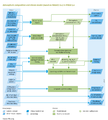Extensive components overview
Jump to navigation
Jump to search
All components of the IMAGE framework per type, i.e. driver components; pressure components; state components; impact components and response components, including key publications and flowcharts.
Click on the flowchart to open the flowchart page.
Driver components
| Component | Main Publications | Flowchart |
|---|---|---|
| Drivers |
|
Pressure components
| Component | Main Publications | Flowchart |
|---|---|---|
| Agricultural economy |
|
|
| Energy conversion |
|
|
| Energy demand |
|
|
| Energy supply |
|
|
| Forest management |
|
|
| Land-use allocation |
|
Interaction components
| Component | Main Publications | Flowchart |
|---|---|---|
| Emissions |
|
|
| Land cover and land use |
|
State components
| Component | Main Publications | Flowchart |
|---|---|---|
| Atmospheric composition and climate |
|
|
| Carbon cycle and natural vegetation |
|
|
| Crops and grass |
|
|
| Nutrients |
|
|
| Water |
|
Impact component
| Component | Main Publications | Flowchart |
|---|---|---|
| Aquatic biodiversity |
|
|
| Ecosystem services |
|
|
| Flood risks |
|
|
| Human development |
|
|
| Land degradation |
|
|
| Terrestrial biodiversity |
|
Response components
| Component | Main Publications | Flowchart |
|---|---|---|
| Air pollution and energy policies |
|
|
| Climate policy |
|
|
| Land and biodiversity policies | No key references defined. |
Related overviews

























